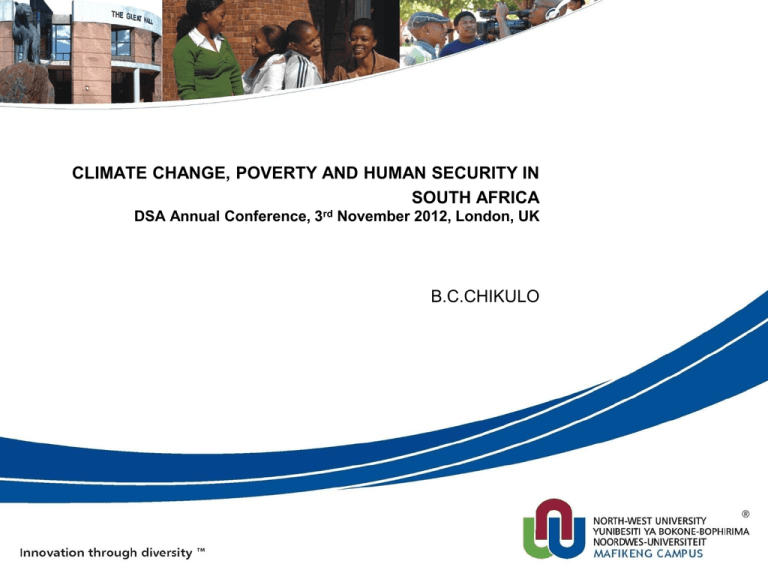Chikulo
advertisement

CLIMATE CHANGE, POVERTY AND HUMAN SECURITY IN SOUTH AFRICA DSA Annual Conference, 3rd November 2012, London, UK B.C.CHIKULO INTRODUCTION This paper examines climate change, poverty and human security issues in South Africa. n South Africa, climate change mitigation poses significant challenges to the South African Government because it has to juggle the needs of its energy-intensive economy based on coal with resultant very high emissions, with the critical issues of poverty and human security, as well as a host of daunting development challenges inherited from the Apartheid regime. The paper is organized into seven sections: Socio-economic Profile of the Country Policy Framework for Poverty Alleviation Policy Frameworks Responses to Climate Change Effects of Climate Change Impacts of Climate Change Delivery of Basic Social Services Poverty and Inequality Conclusion Socio-economic Profile South Africa, has an estimated population of 47.9 million people (SSA 2007b), and is one of the most sophisticated free-market economies on the African continent . South Africa is also the largest emitter of greenhouse gases on the African continent and the world’s biggest single emitter of CO2 at 7.8 tons of CO2 annually (including non-energy emissions). This constitutes the 37th-highest CO2 emissions per capita, higher than many OECD countries (Earthline Africa /Oxfam 2009). While the economy displays many first world-features, including a sophisticated financial and physical infrastructure, good telecommunications and energy supply networks , it is plagued with wide disparities in wealth. However, as a consequence of the legacy of Apartheid, the country’s economic system has the highest marked dualities in the world, with a sophisticated industrial economy existing alongside with an underdeveloped “informal” economy. South Africa’s Gini Co-efficient ranked the country at 117th most economically unequal out of 126 countries; indicating a wide gap between economic wealth and development (UNDP 2007), 47 percent of the population are classified as poor (StatSA 2008). Poverty is unevenly distributed amongst provinces and amongst racial groups. Policy frameworks for Poverty Alleviation In order to alleviate poverty the Government has adopted a number of policy frameworks which include: the Reconstruction and Development Programme (1994) the Growth, Employment and Redistribution Strategy (1996) Accelerated and Shared Growth Initiative (2006) the Urban Development Strategy (1995), the Integrated Sustainable Rural Development Strategy (2000). Anti-Poverty Strategy for South Africa ( 2008) War on Poverty Programme’’(2009) The primary objective has been to combat poverty by overcoming the inherited socio-economic marginalization of the majority of the population through key priority programmes such as: job creation, through public works, meeting a range of basic needs and the delivery of housing, water and electrification . Policy Frameworks and Responses to Climate Change • South Africa has signed and ratified several international conventions and treaties, as well as adopted national, regulatory instruments that underpin environmental and climate change governance issues. These are as follows: • International (global) Frameworks United Nations Environmental Programme (UNEP) Intergovernmental Panel on Climate Change IPCC) (1989) United Nations Framework Convention on Climate Change (UNFCCC1992) Kyoto Protocol (1997) Global Environmental Facility Protocol for the Protection of the Ozone Layer (Montreal Protocol) (1989) India-Brazil-South Africa New Delhi Summit Declaration (2008) Agenda 21 Policy Frameworks and Responses to Climate Change(Cont) National Frameworks RSA Constitution, Act 108 of 1996 National Climate Change Response Strategy (2004) White Paper on Environmental Management Policy (1997) White Paper on Energy Policy (1998) Air Quality Act (2004); White Paper for Sustainable Coastal Development (2000) Environmental Impact Assessment Regulations National Environmental Management Act (1998) Strategic Framework on Sustainable Development in South Africa National Climate Change Response White Paper 2011. The above frameworks provide the broader policy endorsement for climate change mitigation initiatives, as well as the context within which the government seeks to reconcile the tension between development and mitigation objectives. Effects and Causes of Climate Change As a result of the heavy reliance on coal energy sources, South Africa has relatively high emissions per capita, at 7.8 tons CO2 annually (including non-energy emissions (Winkler and Marquand 2009:50). The country’s dependency on coal-fired power stations has resulted in a yearly per capita emission rate of about 10 tons of carbon dioxide, 43 per cent higher than the global average . Most of the emissions come from just two companies Eskom (coal-fired power stations) and Sasol (coal - to - liquids company) (Earthline / Oxfam 2009:6). The country has already been experiencing the early effects of global warming and climate variability. Average land and sea surface temperatures have increased, sea level is rising, rainfall patterns have changed, and the intensity and frequency of extreme weather events such as snow, hail, floods and storms has increased (DEAT 2008,2011). Impact of Climate Change The three major environmental consequences of climate variability are drought, floods and fires (DEAT, 2011; DoST, 2010). Floods Human settlements, formal and informal, low cost and up market are vulnerable to higher risk flooding due heavy rainfalls or coastal storm surges. Extensive flooding of houses and infrastructure with consequential damage to property and human life. Informal (“squatter”) settlements and other low-cost housing estates (RDP houses) are most at risk and have borne the brunt of climate change . Extensive flooding caused by devastating storms and rain, leave many dwellings in these settlements inhabitable thus render thousands of inhabitants homeless. The poor quality of dwellings increases the vulnerability of most poor households to adverse weather conditions, and makes them susceptible to storm damage with several hundred homes being swept away every year. The poor structures are thus vulnerable to extreme weather conditions and are easily damaged or washed away during strong storms and floods (DEAT 2005b:Killian et al 2005). Air pollution and Fires About 19 per cent of the dwellings in South Africa have been classified as being of informal (“squatter”) type or in poor state of disrepair . They are constructed using various materials including wood and cardboard . The use of coal kerosene, liquid petroleum or wood for home cooking and heating, coupled with the abnormally high housing densities also predispose informal settlements to the frequent incidence of accidental intense large fires. Such fires not only destroy hundreds of shacks, but also create hundreds of destitute and homeless people especially in the winter season (Harris and Krueger 2005; Smith 2005). This hazard is recurrent in most of informal settlements with concomitant loss of life and property Human health Climate change provides additional threats that interact with and reinforce existing in the patterns of infectious diseases (Madzwamuse, 2010; DEAT, et al, 2011) South Africa is likely to be exposed to an increase in water and vector borne diseases, particularly malaria and schistosomiasis (bilharzia) ,dengue fever, cholera and dysentery due to a resultant change in the ecosystem changes Effects and Causes of Climate Change(Cont) • • • • Climate change worsens existing vulnerabilities. It means that people living with HIV / Aids and TB in particular would experience increased risk (DEAT,2011:18) The high reliance on polluting fuels, especially the use of paraffin, wood ,coal and candles poses a health risk result ing in high levels of respiratory illness, burns from fires. Exposure to indoor pollution (IAP) also results in several health complications: such as ,i.e., respiratory diseases including chronic obstructive pulmonary disease, lung cancer, nasopharyngeal cancer, and tuberculosis and eye disease. Livelihoods Rising temperatures, reduced rainfall and water scarcity, as well as recurrent floods are having a significant impact on the agricultural systems in South Africa. These impacts include reduction in the amount of available land suitable for both arable and pastoral agriculture, the reduction in the length of the growing season and a decrease in yields. Climate change is also likely to further reduce the contribution of agriculture to the country’s GDP, which has been declining over the years Effects and Causes of Climate Change(Cont) Shifting Migration Patterns The major impacts of the intensified climate variability on migration have been two – fold: national and international. At the national level, the decline in agricultural production and the general vulnerabilities and a lack of opportunities has resulted in increased migration to urban centers (DoST,2010) The result has been growing number of informal settlements and overcrowding in existing ones (SAIRR,2010). At the international level, South Africa has witnessed an influx of foreign nations into the country due to its generous refugee policy. For instance, in 2011 the country experienced an unprecedented level of immigrants of Somali and Ethiopian nations in response to prolonged droughts ,poverty and war in their own countries (UNICEF,2011:31) As a result thousands of Ethiopians and Somalis have made their way to South Africa and settled in townships and informal settlements, swelling the number of foreign nationals ,who include Mozambicans and Zimbabweans leading to mushrooming of informal settlements and overcrowding in existing ones. The combined effect of both national and international migration has been frictions with locals over competition for already scarce resources and social services. Effects and Causes of Climate Change(Cont) Delivery of Basic Social Services and Service Delivery Protests In order to reduce the inherited backlogs of basic social services, the government has since 1994 sought to achieve universal access to basic social services in the whole country. Significant in-roads have been made in providing access to basic services such as electricity, water and sanitation . It is estimated that some 82.6% of households have access to electricity up from 58 % in 1996 but that only half of rural households are electrified. Similarly, some 92.4% have access to safe water source but only 72.2% of households have access to sanitation (SAIRR, 2010). However, despite the significant inroads made in the provision of basic services backlogs remain leading service delivery protests. Between 2004 and 2011 there had been about 285 service delivery protests reported( Karamoko,and Jain,2011:24) Furthermore, the spate of violent service delivery protests tend to occur predominant in urban metro areas (HSRC,2008: South African Citynework,2011) In some instances, these protests have also degenerated into a spate of concentrated violent xenophobic attacks on foreign Africans. Effects and Causes of Climate Change(Cont Poverty and Inequality Despite significant service delivery milestones, little progress has been made on the central objective of reducing poverty and inequality. Between 1998 and 2009 the Human Poverty Index increased from 20 % to 25 %. Furthermore, in South Africa, the face of poverty is often female. It is estimated that 54.4% of poor people in South Africa are women – the equivalent of 11.9 million people. Sixty percent of female-headed households are poor compared to 31% of maleheaded households(DWCPD, 2012:10). Similarly, the unemployment rate had peaked at 31.2% in 2003, dropped to 23% in 2007 and then increased to 24.2 % at the end of 2009 (Presidency,2009) A South African Government’s Millennium Development Goals Mid-term Report indicates that between 1993 and 2006”inequality between races has declined, while inequality within race groups has grown” (RSA 2007:15 emphasis added). The prevailing conditions of poverty and inequality provide an environment for the risks and exposure of the poor to the impacts of climate variability and impacts on human security. Conclusion Climate change in South Africa is wide-ranging and has had a profound impact on the marginalized communities and households Climate change related disasters have been causing death, injury, disease, damage to property, infrastructure, the environment, and disrupting the life of communities. Climate variability also forces people to migrate which in turn results in conflict in the receiving areas due to competition over limited resources and services. Consequently, intense and variable climatic impacts disproportionately affects the poor sector of the population further aggravating the depth of poverty, inequality and insecurity, as well as widening of the gap between the rich and poor. In terms of legislative and policy frameworks, significant efforts have been made with respect to mitigation and adaptation concerning the effects of climate variability, as well as the alleviation of poverty in order to improve human security. The challenge facing the South African Government, however, is how to link the objectives of poverty alleviation policies with those of climate change priorities within a sustainable development framework.








